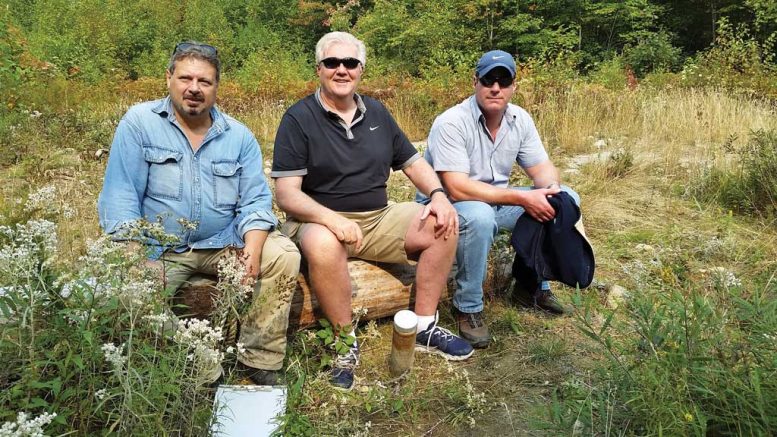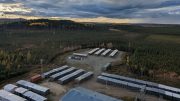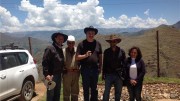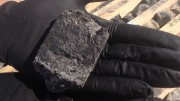SUDBURY, ONTARIO – The optics are rarely very good when a major pulls out of a joint-venture project with a junior company.
In the case of River Valley in northwestern Ontario, now the largest undeveloped primary platinum group metals (PGM) project in Canada, with 2.5 million oz. of near-surface PGMs and gold, Anglo American Platinum spent US$30 million earning a 50% stake, before turning off the taps after the financial crisis struck in 2008.
Anglo Platinum was hunting globally for Bushveld-type igneous complexes, and River Valley was the first one it looked at outside of South Africa. The company’s search went on to encompass Australia, Brazil, China and Russia.
“They were spending a lot of money because they needed to expand outside of South Africa,” explains Trevor Richardson, president and chief operating officer of New Age Metals (TSXV: NAM; US-OTC: PAWEF), which now owns 100% of the project.
What happened next, Richardson says, was beyond anyone’s control. The platinum price tanked and the South African rand came on par with the U.S. dollar. Suddenly, Anglo Platinum was cutting its exploration budgets around the world and at home.
“They had joint ventures in Russia, China, South America — and they pulled out of everywhere,” Richardson says. “So they didn’t pull out from River Valley for technical reasons. They pulled out for budget reasons.”
New Age Metals — which changed its name from Pacific Northwest Capital in January — eventually recovered full control of the project in January 2011, buying it back from Anglo Platinum in shares, and has been advancing River Valley on its own ever since.

New Age Metals’ River Valley project in Ontario. Credit: New Age Metals.
While Anglo Platinum retreated from River Valley, however, the project remained of interest to two key executives at the South African mining company who had worked on the asset between 1999 and 2008, and now sit on New Age Metals’ board of directors and its advisory board.
Ron Hieber, who moved from the junior’s advisory board to its board of directors in June, was in charge of Anglo Platinum’s PGM exploration programs worldwide, and had spent many years heading up the River Valley joint venture.
His colleague, Gordon Chunnet, who is now on New Age Metals’ advisory board, spent 31 years as head of platinum geology and exploration for Anglo Platinum, and is also quite familiar with the project.
“Ron and Gordon were the heads of Anglo Platinum on the technical side for 30 years at least, and were instrumental in where the company’s budget was spent,” Richardson says on a September tour of the River Valley project, 100 km east of Sudbury. “They wouldn’t have come back and got involved if they didn’t believe in this project.”
Hieber says that when he originally worked on the project for Anglo Platinum, River Valley “presented potential in several ways.” Despite lower grades than what he was used to with the Bushveld ores, he says, the River Valley deposits occurred on surface and were wide enough to be mined as an open pit.

Drill core at New Age Metals’ River Valley project in Ontario. Credit: New Age Metals.
“Unlike the Bushveld ores, which are oxidized to around 30 metres’ depth, River Valley mineralization is fresh and therefore amenable to good recoveries right at the start of mining,” he writes in an email from his home in South Africa. “What was missing was a critical mass of mineral resource that could generate an economic return.”
Anglo Platinum’s studies showed that River Valley could be mined profitably on a working cost basis, he says, but it didn’t have enough ore to pay back the capital expense. That problem, however, can be resolved, Hieber says, because the company now has “expanded targets” that can “increase the resource and hence ore reserves, while still supporting open-pit mining.”
The expanded targets Hieber refers to include: a higher-grade area north of the main deposit that the company found in 2015, and is calling the Pine Zone; potential targets farther north of River Valley’s Main Zone; and targets on land it acquired south of the Main Zone in July 2016 from Mustang Minerals (TSXV: MUM).
With the addition of Mustang’s ground, known as the River Valley Extension, New Age Metal’s land in the area has grown to 64 sq. km, and River Valley’s strike length has increased from 12 to 16 kilometres. The deposit is open at depth.
The company confirmed the Pine Zone discovery in December 2016, reporting assay results of 2.57 grams per tonne palladium and platinum over 18 metres from 169 metres downhole in hole 2-6; 1.92 grams palladium and platinum over 20 metres starting from 202 metres in hole 2-10; and 1.84 grams palladium and platinum over 17 metres from 217 metres in hole 2-11.
Earlier holes at Pine Zone returned intercepts of 9 metres grading 3.91 grams palladium and platinum starting from 145 metres in hole 2 and 16 metres of 2.05 grams palladium and platinum from 184 metres downhole in 1.
The Pine Zone is 140 metres from the main resource zone of the deposit and its discovery, New Age Metals says, is a testament to the success the company has had finding near-surface mineralized zones based on induced-polarization (IP) geophysical surveys and 3-D geological modelling. It also underscored “the potential for discovery of similar mineralized zones in other previously overlooked areas at River Valley,” and was an “indication of the camp-scale potential in the under-explored region east of Sudbury.”
Since then, New Age Metals has confirmed that PGM mineralization in the Pine Zone extends to at least 300 metres below surface.
“The Pine Zone generally tends to return higher grades than the original zones that we were drilling throughout most of the exploration program,” says Richard Zemoroz, the company’s project geologist. “It will increase our tonnage, probably add higher grade, and because it will extend the width of the intrusive at that point, or the mineralized zone, it will probably give us a more favorable stripping ratio.”
As for the River Valley Extension property, Zemoroz describes it as “under-explored.”

At the exploration camp on New Age Metals’ River Valley PGM property near Sudbury, Ont., from left: Mike Neumann, director; Harry Barr, chairman and CEO; Trevor Richardson, president and chief operating officer; Susan Mitchell, advisor; and Todd McCracken, consultant. Photo by Trish Saywell.
“Mustang had it for a while and they have done some drilling and some geophysics,” he says, “but there are a lot of places that require more work before we do any drilling there.”
Surface grab samples from the River Valley Extension have returned assay values of up to 10 grams per tonne PGM, and limited drilling has returned intercepts of 1.4 grams per tonne PGM over 9 metres; 4 grams PGM over 2.1 metres; and 2.2 grams PGM over 4.5 metres.
The company’s current exploration focus is finding higher-grade, near-surface mineralization in the northern part of the deposit.
In June, the company completed an IP geophysical survey of the Pine Zone, which remains open along strike and at depth, and extended the IP survey to include the Banshee Zone, 2 km southeast along the trend of the River Valley Main Zone. (In 2003, 25 holes were drilled into Banshee and surface exploration and geophysics outlined a zone of over 600 metres.)
The surface IP survey over the Pine Zone tested the potential for eastwards and southwards extensions, as well as the adjacent Dana North Zone. The company says there is 2 km of untested potential for more mineralization along the trend between the drilled extent of the Pine Zone and the under-explored Pardo Zone to the northwest.
In July, New Age Metals kicked off a 5,000-metre drill program. The program will follow up drilling to test the continuation of the Pine Zone and the Dana North Zone. The drilling is mainly exploratory and intended to test the footwall mineralization in the northern part of the property.
In September, the company reported drill holes from the Dana North Zone. The best result was an intercept of 2.45 grams per tonne palladium, platinum and gold over 28 metres, including 7.12 grams palladium, platinum and gold over 3 metres.
“If you’re talking about the Bushveld, they’re mining widths of over one or two metres, and they’re like eight grams per tonne, so that 7.12 grams over 3 metres is a really good intercept — that’s a world-class intercept,” Zemoroz says.
“We’re so excited about those results,” Richardson says. “Those are really big thicknesses, which makes it easier to mine open cast.”
River Valley — halfway between North Bay and Sudbury — is one of the largest nickel-copper-PGM sulphide mining and metallurgical centres in the world, containing 3.9 million equivalent oz. palladium in the measured and indicated category and another 1.2 million equivalent oz. palladium in inferred.
The latest resource estimate, from May 2012, identified measured and indicated resources of 91.3 million tonnes grading 0.58 gram per tonne palladium, 0.22 gram per tonne platinum and 0.04 gram gold, at a cut-off grade of 0.8 gram per tonne palladium equivalent. Inferred resources add 35.91 million tonnes grading 0.36 gram palladium, 0.14 gram platinum and 0.03 gram gold.
The company plans to start updating the resource this fall, with drilling it has completed since 2012, and says it will embark on a preliminary economic assessment next year.

A drill rig at New Age Metals’ River Valley project in Ontario. Credit: New Age Metals.
The River Valley intrusive covers 200 km within the Grenville Front Tectonic Zone, a 900-metre thick, mafic, sulphide-poor layered intrusion. The project’s mineralized areas all contain PGMs, gold and small amounts of copper and nickel that could count as credits at any future mine.
Metallurgical work by SGS in 2013 produced bulk sample grades of 16% copper, 2% nickel and 189 grams per tonne PGM, and metal recoveries of 84% copper, 22% nickel and 69% PGMs. Because it has no deleterious metals, a sulphide concentrator could effectively process material from River Valley.
The company is weighing processing options that include dense media separation to remove the sulphides. The PEA will assess various processing options.
Hieber notes that there have been advances in processing PGM ores at lower capital costs, “and if these methods work on River Valley, which is not yet known, the economics look better.”
Only about 10 million oz. palladium are produced in any given year, and most of it comes from Russia and South Africa. Richardson forecasts total demand this year will surpass 10 million oz. for the second year in a row and points to a dearth of palladium-rich projects that can fill the gap.
“There’s going to be a deficit because the mines in South Africa have become much deeper and more expensive to mine. There’s nothing new coming online — we went through that lag period, when no one was doing exploration.”
“Several South African deposits have reached their sell-by dates (and some have been sold) and although PGM markets have lost a lot of luster, in time, the loss of South African production will express itself in improved prices,” Hieber says. “All of this suggests that there is a lot to look forward to with River Valley, where there is an experienced team in place from the president down.”
In addition to its aging mines, South Africa is not seen as a particularly appetizing jurisdiction in which to operate, Richardson argues, which could lead to more mining companies moving outside the country in search of new assets.
As proof he points to Johannesburg-listed Sibanye Gold’s US$2.2-billion acquisition in May of Stillwater Mining, the only U.S. PGM miner and the largest primary producer of the precious metals outside of South Africa and Russia.
“What you’re going to start seeing is those South African companies diversifying their risk and coming back to North America,” he says. “Sibanye buying Stillwater was proof — that was the first one — and I think you’ll start seeing the others begin saying if Sibanye can do that, we can too.”
“Not a lot of people know PGMs and there is only one mine in Canada,” Richardson adds, referring to North American Palladium’s (TSX: PDL; US-OTC: PALDF) Lac des Îles mine, 90 km northwest of Thunder Bay, Ontario. That mine has been in production for over 20 years, and North American Palladium is the only pure-play palladium producer in the world.
“If you asked anyone to name ten gold projects, they could probably do it,” Richardson says, “but ask them to name ten palladium projects and I bet they couldn’t. I couldn’t!”
Richardson, a geologist, also notes that North American Palladium started off “with a similar type of scenario” to River Valley, “and then when they went underground, they started getting much better grade.”
“Now we have the opportunity to drill deeper holes, and we may or may not find the same thing. They are very similar type deposits.”
New Age Metals’ vision is that River Valley will become an open-pit mine, with a concentrator on-site. The concentrate would then be sent to a smelter in Sudbury, where concentrates from North American Palladium’s Lac des Îles are also sent.
Jon Hykawy, president of Stormcrow Capital, says he’s impressed with New Age Metals’ team — “not just in terms of the management group but the wider group of consultants” — and says he’s seen very few projects with better infrastructure.
“I guess it’s going to come down to how well the metallurgy works and what the appetite is out in the market for a PGM project,” he says.
While the price of palladium has been rising for nearly three years in a row and sits at US$930 per oz., many investors believe the move towards electric vehicles means that the longer-term prospects look dim for platinum and palladium. The two metals are used in catalytic converters in gasoline-powered and diesel-powered vehicles to clean up exhaust.
But Hykawy, who has a PhD in physics, doesn’t agree. “A lot of people have decided the market has spoken and the solution is a battery-powered car, and to my mind that’s facile and silly,” he says. “The issue with batteries is they’re great at power generation, but lousy at storing energy.
“If you look at a Tesla,” he says, “you realize very quickly that not only is it an expensive vehicle, but for all of Tesla’s attempts to sugar-coat it, the car requires adaptation from the owner.”
If you are used to the idea that you can jump in your car in Montreal, drive to Toronto and turn around and drive back to Montreal, and do so whenever you like, then electric vehicles could be a problem, Hykawy says.
“Today you can probably do that drive from Montreal to Toronto and back, because you’ll probably find an electric charging station. But in future, when all those charging stations are occupied, you may have a very difficult time finding a place to charge that’s convenient for you and that is also available, and has a spot open to you when you want it,” he says.
“They are already seeing that impact in parts of Europe and China, and this begs the question: ‘Should there be some charging system onboard, and what sort of charging system should it be?”
For his part, Harry Barr, New Age Metals’ founder, chairman and CEO, who has spent more than 30 years cutting deals and raising money in the mining industry, is a true believer in River Valley.
“In 2000 we had a little 5¢ stock that went to almost $5 on the strength of a brand-new discovery called River Valley, and we started the largest staking rush in the history of the Sudbury mining district,” he says.
“Management has about $3 million in this personally, and a lot of that is my money, so this has become a personal thing to me and I do want it to work.”
Of the company’s 2,000 shareholders, 10.08% are management and insiders, 10.23% is owned by merchant bank Palisade Global Investments and 1.32% by Kaymin Resources, a wholly owned subsidiary of Anglo Platinum.
The junior has 68.5 million common shares outstanding and has been trading within a 52-week range of 5¢ to 15¢ per share. At press time its shares were trading at 6¢ apiece.






Be the first to comment on "Site visit: New Age Metals finds high grade"